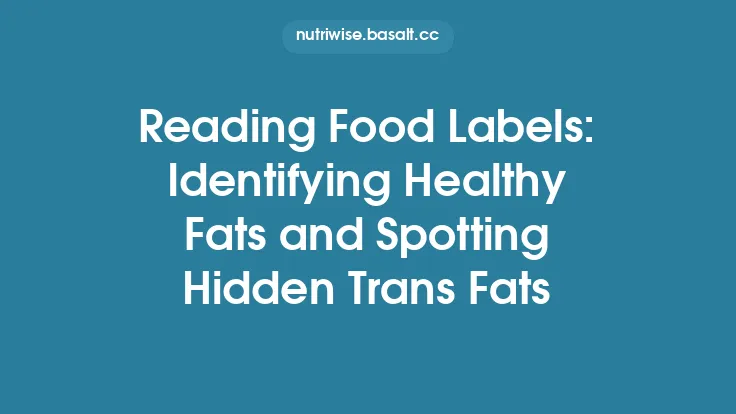When you walk down the grocery aisle, the most powerful tool you have for judging the nutritional merit of a product is the information printed on its package. While taste, price, and brand loyalty often drive the first impression, a careful look at the label can reveal whether the macronutrients—protein, fat, and carbohydrate—are presented in a form that supports health goals, athletic performance, or specific dietary needs. This article walks you through every element of a typical nutrition label, explains how to interpret the data, and offers practical strategies for turning raw numbers into actionable insight.
Decoding the Nutrition Facts Panel: Layout and Key Terms
The Nutrition Facts panel (or Nutrition Information table) is standardized to make comparison across products easier. In the United States, the panel is organized into distinct rows and columns that follow a predictable order:
| Row | What It Shows | Why It Matters |
|---|---|---|
| Serving Size | The amount that the nutrition information pertains to (e.g., “1 cup (240 g)”). | All subsequent numbers are based on this quantity; misreading it can lead to over‑ or under‑consumption. |
| Calories | Total energy provided per serving. | Helps gauge overall energy density; a high‑calorie product isn’t automatically “bad” if the calories come from nutrient‑dense macros. |
| Total Fat | Sum of all fatty acids (g). | Followed by a breakdown of saturated, trans, monounsaturated, and polyunsaturated fats. |
| Cholesterol | Amount of cholesterol (mg). | Relevant for individuals monitoring heart health. |
| Sodium | Sodium content (mg). | Excess sodium is linked to hypertension; the %DV helps assess contribution to the daily limit. |
| Total Carbohydrate | Sum of all carbohydrate types (g). | Followed by dietary fiber, total sugars, and added sugars. |
| Protein | Total protein (g). | Further quality cues appear in the ingredient list and sometimes in a “complete protein” claim. |
| Vitamins & Minerals | Selected micronutrients (e.g., Vitamin D, Calcium). | Not the focus of this article but useful for overall nutrient balance. |
Below the main table, the % Daily Value (%DV) column translates each nutrient into a percentage of the recommended intake for a 2,000‑calorie diet. While the 2,000‑calorie reference is a generic benchmark, it provides a quick visual cue: values > 20 % are “high,” and ≤ 5 % are “low.”
Serving Size Matters: How to Normalize Comparisons
Manufacturers can set the serving size to make a product appear more favorable. For instance, a granola bar listed as “1 bar (30 g)” may contain 150 kcal, 5 g protein, and 8 g sugar. The same product sold in a 100‑g family pack will list the same numbers per 30‑g serving, but the total package delivers over three times the calories and sugars.
Practical steps to normalize:
- Convert to a common basis – Use the “per 100 g” or “per 1 cup” metric, which many labels provide in a secondary column. If not present, calculate:
\[
\text{Nutrient per 100 g} = \frac{\text{Nutrient per serving} \times 100}{\text{Serving size (g)}}
\]
- Compare like‑for‑like – When evaluating two products (e.g., two yogurts), ensure you’re looking at the same gram weight or volume.
- Mind the “per container” footnote – Some multi‑serve packages list “per container” values that can be misleading if you only consume one serving.
Protein Quality Indicators on the Label
Not all protein is created equal. While the label lists total grams, the biological value (how efficiently the body utilizes the protein) depends on amino acid composition and digestibility. Here’s how to infer quality from the label:
| Indicator | Where to Find It | What It Tells You |
|---|---|---|
| Complete Protein Claim | Front‑package or ingredient list (e.g., “contains all essential amino acids”). | Suggests a balanced amino acid profile, typical of animal proteins, soy, quinoa, or fortified blends. |
| Protein Source | Ingredient list (first few ingredients). | “Whey protein isolate,” “egg whites,” “pea protein” are high‑quality; “hydrolyzed collagen” lacks essential amino acids for muscle synthesis. |
| PDCAAS or DIAAS | Rarely on consumer labels, but may appear on specialty sports nutrition products. | Provides a numeric score (0–1) for protein quality; a value ≥ 0.9 is considered high. |
| Leucine Content | Occasionally highlighted on performance‑oriented products. | Leucine is a key trigger for muscle protein synthesis; ≥ 2.5 g per serving is often targeted. |
If these cues are absent, prioritize products where the protein source appears early in the ingredient list and is a recognizable, minimally processed protein (e.g., “milk,” “egg,” “soy”).
Fat Quality: Saturated, Monounsaturated, Polyunsaturated, and Trans Fats
The total fat number alone tells little about health impact. The breakdown provides the real story:
- Saturated Fat – Listed directly under total fat. Aim for ≤ 5 % of total calories (≈ 10–12 g on a 2,000‑calorie diet). High levels often indicate animal fats or tropical oils (coconut, palm).
- Trans Fat – Must be listed if > 0 g; many manufacturers now report “0 g” if < 0.5 g per serving. Look for “partially hydrogenated oil” in the ingredient list, which signals hidden trans fats even when the panel reads zero.
- Monounsaturated (MUFA) & Polyunsaturated (PUFA) Fats – Frequently omitted from the standard panel but may appear on the “fatty acid profile” of specialty products (e.g., “contains 2 g omega‑3 EPA/DHA”). When present, higher MUFA/PUFA relative to saturated fat is a positive sign.
- Omega‑3 & Omega‑6 – Not required on most labels, but if the product advertises “high in omega‑3” or “balanced omega‑6/omega‑3 ratio,” verify the actual gram amounts in the ingredient list or supplemental facts.
Interpretation tip: A product with 12 g total fat, of which 8 g are saturated, is a poor source of healthy fats, even if the total fat appears modest.
Carbohydrate Breakdown: Fiber, Sugars, and Added Sugars
Carbohydrates are split into three key sub‑categories:
- Dietary Fiber – Listed under total carbohydrate. Soluble fiber (e.g., β‑glucan) can lower cholesterol; insoluble fiber supports gut motility. Aim for ≥ 3 g per serving for a meaningful contribution.
- Total Sugars – Includes both naturally occurring and added sugars. A high total sugar number can be misleading if the product is a fruit puree (natural sugars) versus a sweetened snack.
- Added Sugars – Required on U.S. labels (since 2020) and increasingly on EU and Canadian labels. This figure isolates sugars introduced during processing (e.g., sucrose, high‑fructose corn syrup). Keeping added sugars ≤ 10 % of total calories (≈ 50 g per day) aligns with most dietary guidelines.
Special cases:
- Sugar Alcohols (e.g., erythritol, xylitol) appear under “Total Carbohydrate” but are not counted as sugars. They contribute fewer calories and have a lower glycemic impact, but excessive intake can cause gastrointestinal distress.
- Polyols (e.g., sorbitol) are sometimes listed separately; they are partially absorbed and can affect blood glucose modestly.
When evaluating a “low‑carb” product, verify that the carbohydrate reduction isn’t achieved by replacing sugars with sugar alcohols that may have hidden caloric content or digestive side effects.
The Ingredient List: Spotting Whole vs. Refined Sources
The ingredient list, ordered by weight from highest to lowest, reveals the quality of the macronutrient sources:
| Macro | High‑Quality Ingredient Examples | Red Flag Indicators |
|---|---|---|
| Protein | “Whey protein isolate,” “egg white protein,” “pea protein,” “grass‑fed beef.” | “Protein blend,” “hydrolyzed collagen,” “textured vegetable protein” (often highly processed). |
| Fat | “Extra‑virgin olive oil,” “avocado oil,” “nuts,” “seeds.” | “Partially hydrogenated oil,” “vegetable oil blend,” “palm oil” (often high in saturated fat). |
| Carbohydrate | “Whole grain oats,” “brown rice,” “legume flour,” “fruit puree.” | “Enriched wheat flour,” “high‑fructose corn syrup,” “maltodextrin,” “modified starch.” |
Key strategies:
- First three ingredients rule: If a high‑quality source appears within the first three ingredients, it likely contributes a meaningful portion of the macro.
- Look for “whole” descriptors: “Whole grain,” “whole‑food,” “unrefined” are positive signals.
- Beware of “flavors” and “extracts”: These can mask added sugars or fats, especially when listed near the end of the list but still present in non‑trivial amounts.
Front‑Package Claims: What They Really Mean
Manufacturers use marketing language to highlight perceived benefits. Common claims include:
- “Low Fat” – Means ≤ 3 g total fat per serving (U.S. regulation). It does not guarantee low calories; sugar may be added to compensate for flavor.
- “High Protein” – Must contain at least 20 % of the calories from protein. Verify by dividing protein grams × 4 kcal/g by total calories.
- “No Added Sugar” – Indicates no sugars were added during processing, but natural sugars from fruit, milk, or dairy may still be present.
- “Reduced Calorie” – At least 25 % fewer calories than the standard reference product. Check the reference product’s label to confirm the reduction.
- “Gluten‑Free” – Must contain < 20 ppm gluten. This claim does not affect macronutrient quality but can be relevant for celiac disease.
Interpretation tip: Treat claims as a starting point, then verify the underlying numbers in the Nutrition Facts panel and ingredient list.
Understanding % Daily Value and Contextualizing Numbers
The %DV is anchored to a 2,000‑calorie reference, but individual needs vary:
- Active athletes may require 2,500–3,000 kcal, making a 20 % DV of protein (≈ 50 g) appear modest.
- Weight‑loss plans often target 1,200–1,500 kcal, where a 20 % DV of fat (≈ 7 g) could be relatively high.
To personalize the %DV:
- Calculate your own daily target for each macro (e.g., 30 % of calories from protein = 0.30 × 2,500 kcal ÷ 4 kcal/g ≈ 188 g protein).
- Convert the label’s %DV to grams using the reference values (e.g., 10 % DV of saturated fat = 2 g, because the reference is 20 g).
- Scale to your target – If your saturated fat limit is 15 g, a 2 g serving represents 13 % of your personal limit.
This approach turns generic percentages into actionable data aligned with personal goals.
International Labeling Standards: U.S., EU, Canada, and Beyond
While the core concepts are similar, regional regulations differ in presentation and required disclosures:
| Region | Mandatory Elements | Notable Differences |
|---|---|---|
| United States (FDA) | Serving size, calories, total fat, saturated fat, trans fat, cholesterol, sodium, total carbohydrate, dietary fiber, total sugars, added sugars, protein, %DV for 5 nutrients. | “Added sugars” required; trans fat can be listed as 0 g if < 0.5 g. |
| European Union (EU) | Energy (kJ/kcal), fat, saturates, carbohydrate, sugars, protein, salt. No mandatory %DV, but reference intakes (RI) are shown. | No separate “added sugars” line; “saturates” used instead of “saturated fat.” |
| Canada | Similar to U.S. but includes “% Daily Value” for all nutrients and a “Nutrition Facts” table with a mandatory “% DV” column. | “Trans fat” must be listed even if 0 g; “added sugars” not yet mandatory (as of 2025). |
| Australia/New Zealand (FSANZ) | Energy (kJ), protein, fat, saturated fat, carbohydrate, sugars, dietary fiber, sodium. | Uses “%RI” (Reference Intake) and includes a “% of daily intake” for each nutrient. |
When comparing products imported from another region, convert the units (e.g., 1 g = 9 kcal for fat) and be aware of differing thresholds for labeling “0 g” (U.S. < 0.5 g, EU < 0.2 g).
Using Labels to Evaluate Processed Foods vs. Minimally Processed Options
Processing level often influences macronutrient quality, but the label can help you differentiate without needing to know the exact processing method:
- Highly processed items tend to have:
- Long ingredient lists with multiple additives (e.g., emulsifiers, preservatives).
- High added sugar and refined grain content.
- Low fiber and a high proportion of saturated or trans fats.
- Minimally processed foods (e.g., plain Greek yogurt, canned beans in water) usually feature:
- Short ingredient lists (often a single ingredient).
- Naturally occurring macronutrients with minimal added sugars or fats.
- Higher fiber and a more balanced fatty acid profile.
By cross‑referencing the ingredient list with the macro breakdown, you can infer the processing intensity and decide whether the product aligns with your quality standards.
Practical Tips for Quick Label Audits in the Grocery Aisle
- Grab the “big three” numbers first: total protein, total saturated fat, and added sugars.
- Check the first two ingredients – if they are whole‑food sources (e.g., “whole oats,” “chicken breast”), the macro quality is likely higher.
- Scan for hidden fats: look for “oil” or “fat” in the ingredient list even if total fat appears low.
- Use the “per 100 g” column to compare products of different package sizes.
- Note the serving size – if it’s unusually small (e.g., “1/4 cup”), calculate the nutrients for a realistic portion.
- Look for “no added” claims (e.g., “no added salt”) and verify by checking sodium levels; a “no added salt” product can still be high in sodium from natural sources.
Common Pitfalls and Misleading Practices to Watch Out For
- “Zero” claims that hide small amounts: “0 g trans fat” may still contain up to 0.5 g per serving.
- “Reduced” vs. “Light” vs. “Low”: “Reduced” indicates a ≥ 25 % decrease from a reference product; “light” can mean ≤ 3 g of fat or ≤ 40 % of calories from fat; “low” has specific regulatory thresholds (e.g., ≤ 3 g total fat).
- Sugar‑alcohol overuse: Products marketed as “sugar‑free” may contain large amounts of polyols, leading to a higher total carbohydrate count and possible digestive upset.
- Protein “boosters” that dilute quality: Adding isolated whey protein to a snack bar can raise the protein number, but if the bar still contains high amounts of refined carbs and saturated fat, the overall macro quality remains poor.
- Fortification that masks poor macro balance: A cereal may be fortified with vitamins and minerals, yet still be high in added sugars and low in fiber.
Leveraging Digital Tools and Apps for Deeper Analysis
Modern nutrition apps can scan barcodes and instantly break down macro ratios, compare products side‑by‑side, and even calculate personalized %DV based on your caloric goals. When using these tools:
- Verify the database – Ensure the app pulls data from the most recent label (some databases lag behind label updates).
- Customize macro targets – Input your specific protein, fat, and carbohydrate goals; the app will recalculate %DV accordingly.
- Set alerts for thresholds – Many apps let you flag “added sugars > 5 g” or “saturated fat > 3 g” per serving, helping you stay within your limits.
- Export data for meal planning – Exporting the nutrient breakdown into a spreadsheet allows you to aggregate totals across meals and spot hidden macro imbalances.
By combining a keen eye for label details with digital assistance, you can make informed choices that align with both short‑term dietary needs and long‑term health objectives.
In summary, the nutrition label is a roadmap to the macronutrient quality of any packaged food. Understanding the layout, interpreting the numbers in context, scrutinizing the ingredient list, and being aware of regulatory nuances empower you to select foods that truly support your nutritional goals—whether you’re aiming for muscle gain, weight management, or simply a healthier everyday diet. Armed with these skills, the next time you stand before the shelves, the label will speak louder than the marketing hype.





